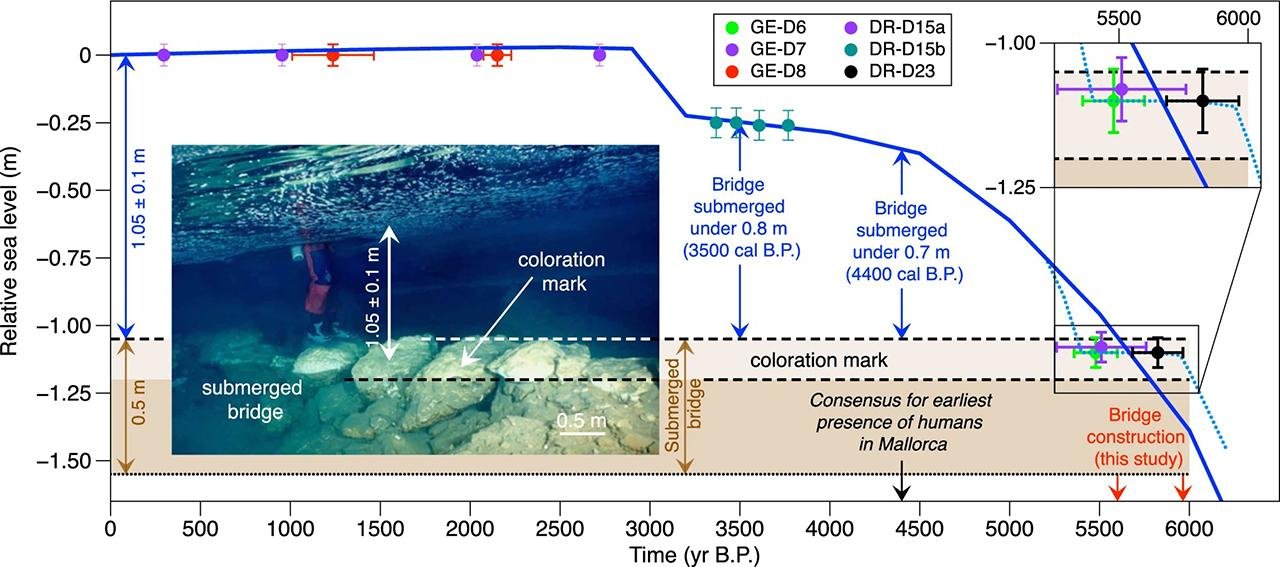Recent findings from an ancient submerged limestone bridge inside Genovesa Cave on the Spanish island of Mallorca suggest that humans settled the western Mediterranean much earlier than previously believed. This discovery, detailed in a study published in the journal Communications Earth & Environment, has pushed back the timeline for human habitation on Mallorca by approximately 1,600 years.
 An underwater view of the 5,600-year-old submerged limestone bridge located inside a submerged cave. Credit: R. Landreth
An underwater view of the 5,600-year-old submerged limestone bridge located inside a submerged cave. Credit: R. Landreth
The submerged limestone bridge, which is 25 feet long and composed of large limestone blocks, was first discovered during a scuba-diving expedition in 2000. Initial estimates, based on pottery fragments found in the cave, suggested that the bridge was constructed around 4,400 years ago. However, these estimates were later deemed inaccurate due to the poor preservation of radiocarbon-dated materials like bones and pottery found nearby.
“Earlier findings were based on fragmented artifacts and bone remains, leading to inconsistencies and doubts about the actual timeline of human settlement,” explained Bogdan Onac, a professor of geology at the University of South Florida and the study’s lead author.
The research team, led by Onac, revisited the bridge in recent years with a new focus on understanding local sea-level changes. By studying a distinct “bathtub ring” of mineral deposits, also known as speleothems, along the upper portion of the bridge, researchers were able to reconstruct historical sea levels and determine a more accurate date for the bridge’s construction. These mineral formations, along with the coloration of the bridge, indicated that it was built nearly 6,000 years ago, aligning with a period of stable sea levels between 5,964 and 5,359 years ago.
 Proposed timing for bridge construction. Credit: Onac, B.P., Polyak, V.J., Mitrovica, J.X. et al., Commun Earth Environ 5, 457 (2024)
Proposed timing for bridge construction. Credit: Onac, B.P., Polyak, V.J., Mitrovica, J.X. et al., Commun Earth Environ 5, 457 (2024)
“The presence of this submerged bridge and other artifacts indicates a sophisticated level of activity, implying that early settlers recognized the cave’s water resources and strategically built infrastructure to navigate it,” Onac told CNN. This new timeline suggests that humans were present on Mallorca much earlier than previously believed.
The bridge is a significant find because it suggests a higher level of planning and resource use among early settlers. Researchers believe that the bridge, made of limestone blocks, was constructed to provide a dry path across a lake within the cave, facilitating access to a dry chamber beyond. This area may have served various purposes, including as a refuge, a ritual site, or storage to protect food from the H๏τ climate of Mallorca.
“The time when the bridge was constructed also shows that people were utilizing this cave much earlier than previously thought, closing the gap between eastern and western Mediterranean settlements,” Onac said.
Mallorca, one of the largest islands in the Mediterranean, was one of the last in the region to be inhabited. This is in stark contrast to other Mediterranean islands like Cyprus and Crete, which were settled at least 9,000 years ago. The island’s H๏τ, dry climate, combined with thin soil that made farming difficult, likely contributed to the delayed human settlement.
“Mallorca’s challenging environment and limited resources might have deterred early human settlers,” Onac said. “In contrast, other islands had more favorable environmental conditions and abundant resources, making them more attractive.”
The discovery of the bridge and the new timeline for human settlement opens the door for further exploration and study. Researchers aim to better understand the broader implications of early human activity on the island and the reasons behind the construction of structures like the bridge in Genovesa Cave.
More information: Onac, B.P., Polyak, V.J., Mitrovica, J.X. et al. (2024). Submerged bridge constructed at least 5600 years ago indicates early human arrival in Mallorca, Spain. Commun Earth Environ 5, 457. DOI:10.1038/s43247-024-01584-4





